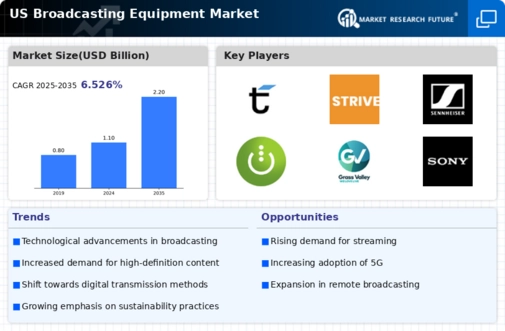Expansion of Streaming Services
The rise of streaming services significantly influences the broadcasting equipment market. With platforms like Netflix and Hulu expanding their offerings, traditional broadcasters are adapting to this shift by enhancing their equipment capabilities. This adaptation includes the integration of cloud-based solutions and advanced encoding technologies to facilitate seamless streaming. The market is projected to reach a valuation of $10 billion by 2027, driven by this transition. As content creators seek to deliver engaging experiences, the broadcasting equipment market is evolving to support diverse formats and distribution channels, ensuring that broadcasters remain competitive in a rapidly changing landscape.
Regulatory Changes and Compliance
Regulatory changes play a crucial role in shaping the broadcasting equipment market. The Federal Communications Commission (FCC) enforces standards that impact equipment specifications and operational practices. Compliance with these regulations often necessitates upgrades to existing equipment, thereby driving market growth. For instance, the transition to digital broadcasting has prompted many broadcasters to invest in new transmission technologies. The broadcasting equipment market must navigate these regulatory landscapes, which can create both challenges and opportunities for manufacturers. As compliance becomes increasingly complex, the demand for innovative solutions that meet regulatory requirements is likely to rise.
Emergence of Virtual and Augmented Reality
The emergence of virtual and augmented reality (VR and AR) technologies is reshaping the broadcasting equipment market. As these immersive technologies gain traction, broadcasters are exploring new ways to engage audiences. The integration of VR and AR into broadcasting requires specialized equipment, such as advanced cameras and software solutions. This trend is expected to drive market growth, with projections indicating a potential increase of 15% in equipment sales related to VR and AR applications by 2028. The broadcasting equipment market is thus positioned to capitalize on this trend, as content creators seek innovative ways to enhance viewer experiences.
Increasing Demand for High-Quality Content
The broadcasting equipment market experiences a notable surge in demand for high-quality content production. As audiences increasingly expect superior visual and audio experiences, broadcasters are compelled to invest in advanced equipment. This trend is reflected in the market's projected growth rate of approximately 8% annually through 2026. The need for high-definition and 4K content drives the adoption of sophisticated cameras, microphones, and editing tools. Consequently, manufacturers are innovating to meet these demands, leading to a competitive landscape. The broadcasting equipment market is thus witnessing a transformation, where quality becomes a key differentiator among service providers.
Adoption of IP-Based Broadcasting Solutions
The shift towards IP-based broadcasting solutions is transforming the broadcasting equipment market. This transition allows for greater flexibility and scalability in broadcasting operations. By utilizing Internet Protocol (IP) technologies, broadcasters can streamline their workflows and reduce costs associated with traditional broadcasting methods. The market for IP-based equipment is expected to grow at a CAGR of 10% over the next five years. This trend indicates a significant shift in how content is produced and distributed, with the broadcasting equipment market adapting to these technological advancements. As broadcasters seek to enhance efficiency, the demand for IP solutions is likely to increase.






















Leave a Comment